Kafka速览
一、基本结构
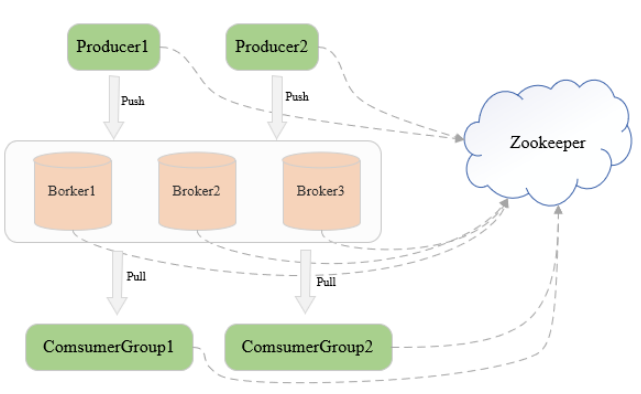
三台机器组成的Kafka集群,每台机器启动一个Kafka进程,即Broker
向broker发送消息的客户端是Producer,拉取消息的客户端是Consumer
Producer和Consumer都是用户实现的
broker只负责数据存储,不保存任何Producer和Consumer的信息
Kfaka通过zookeeper管理集群
broker和集群的一些信息,即元信息都保存在zookeeper中
一个ConsumerGroup可以包含一个或多个Consumer
同一个消费者组里的不同消费者是互斥的,在一个消费者组里,一条消息运行被一个Consumer消费,不会出现同一条消息被一个消费者组多次消费的情况
Topic与Partition
Kafka集群由多个实例组成,每个节点称为Broker,对消息保存时根据Topic进行归类
一个Topoic可以被划分为多个Partition
每个Partition可以有多个副本,多副本冗余存储可以保证某个副本的机器出现故障,其他副本可正常使用,副本尽量分布到不同的broker上,分区的每个副本都有一个leader,负责读写请求,其他副本只从leader中同步数据,leader挂掉会从follower中选举新的leader
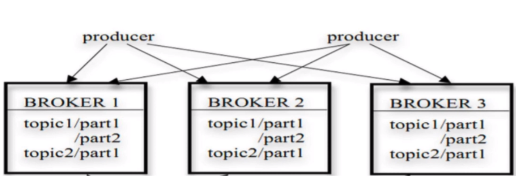
一个topic可看成数据库中的一个表
消费者可以并行处理Partition中的数据
Partition内顺序存储,写入新消息采用追加的方式,消费消息采用FIFO的方式顺序拉取消息
一个Topic可以有多个分区,Kafka只保证同一个分区内有序,不保证Topic整体(多个分区之间)有序
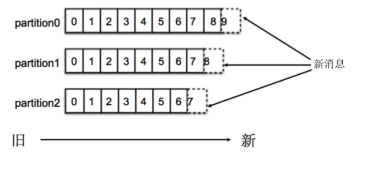
ConsumerGroup
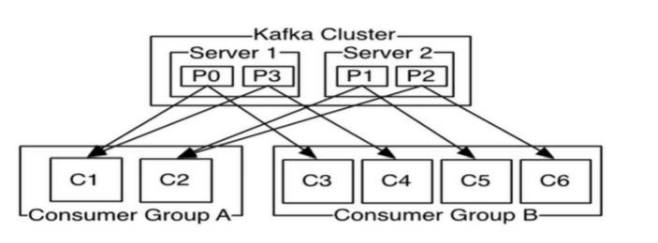
CG,为了加速读取速度,多个consumer可以划分为一个组,并行消费一个Topic
一个Topic可以由多个CG订阅,多个CG之间是平等的,同一个CG内可以有一个或多个consumer,同一个CG内的consumer之间是竞争关系,一个消息在一个CG内的只能被一个consumer消费
核心概念总结:
- Broker:启动Kafka的一个实例就是一个broker,一个kafka集群可以启动多个broker
- Topic:相当于数据库中的表,productor将消息写入的一个topic中,consumer从同一个topic消费消息
- Partiton:一个topic可以设置多个分区,相当于把一个数据集分成多份分别放到不同的分区中存储,一个topic可以有一个或者多个分区,分区内消息有序
- Replication:副本,一个Partition可以设置一个或多个副本,副本主要保证系统能够持续不丢失的对外提供服务,提高系统的容错能力
- Producer:消费生产者,负责向Kafka中发布消息
- Consumer Group:消费者所属组,一个Consumer Group可以包含一个或多个consumer,当一个topic被一个Consumer Group消费的时候,Consumer Group内只能有一个consumer消费同一条消息,不会出现同一个Consumer Group多个consumer同时消费一条消息造成一个消息被一个Consumer Group消费多次的情况
- Consumer:消息消费者,consumer从kafka指定的主题中拉取消息
- Zookeeper:Zookeeper在Kafka集群中主要用于协调管理,Kafka将元数据信息保存在zookeeper中,通过zookeeper管理和维护整个Kafka集群的动态扩展、各个Broker负载均衡、Partition leader选举等
二、Kafka存储
每个topic可以有多个分区,每个分区在物理磁盘上就是一个文件夹(目录)
蓝色前本部分是所属topic的名称,后面的数字是分区的编号

在每个分区里有多个segment文件
Segment:段文件,Kafka中最小存储单位,一个partition包含多个segment文件,每个segment是以message在partition中的起始偏移量命名以log结尾的文件
Offset:消息在分区中的偏移量,用来在分区中唯一的标识一条信息

索引文件
Kafka为了提高写入、查询速度,在partition文件夹下每一个segment log文件都有同名的索引文件,在Kafka0.10以后的版本中会存在两个索引文件
- 一个是以index结尾的偏移量索引文件
- 另一个是以timeinde结尾的时间戳索引文件

偏移量索引文件
以偏移量作为名称,index为后缀
索引内容格式:offset,position
采用稀疏存储方式
通过log.index.interval.bytes设置索引跨度
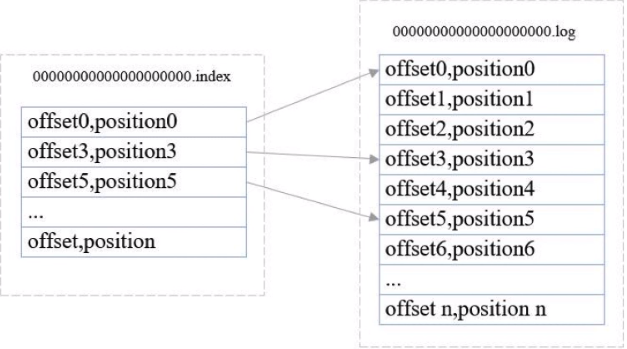
比如查找offset4的消息
consumer首先确定在哪个数据文件和索引文件中
通过偏移量索引文件查找小于等于指定偏移量最大的偏移量,上面再索引文件中找到offset3
根据offset3指向的数据文件里面对应的地方往下找,找到offset4
时间戳索引文件
以时间戳为名称,以timeindex为后缀
索引内容格式:timestamp,offset
采用稀疏存储方式
通过log.index.interval.tytes设置索引跨度
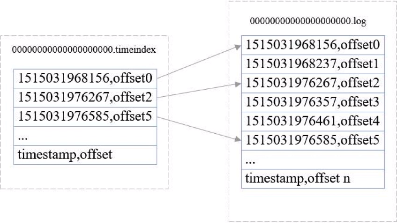
查找过程同偏移量索引
三、高可用的实现
多分区多副本
- 一个topic可以有多个分区,每个分区可以有多个副本
- 0.8以前没有Replication,一旦某台broker宕机,其上partition数据便丢失
- 同一个partition的不同副本分不到不同的broker
- 一个分区的多个副本选举一个leader,由leader负责读写,其他副本作为follower从leader同步消息
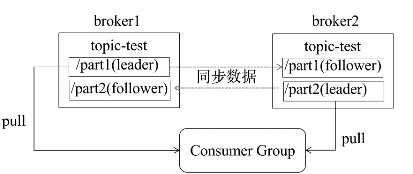
Kafka Controller选举
- 从集群中的broker选举出一个Broker作为Controller控制节点
- 负责整个集群的管理,如Broker管理、Topic管理、Partition Leader选举等
- 选举过程所有的Broker向Zookeeper发起创建临时znode的请求,成功创建znode的Broker胜出作为Controller,未被选中的Broker监听Controller的znode,等待下次选举
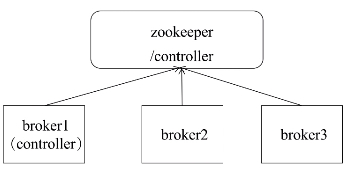
Kafka Partition Leader选举
- Controller负责分区Leader选举
- ISR列表 在zookeeper中
Follower批量从Leader拖取数据
Leader跟踪保持同步的flower列表ISR(In Sync Replica),ISR作为下次选主的候选列表
Follower心跳超时或者消息落后太多,将被移除出ISR
- Leader失败后,从ISR列表中选择一个Follower作为新的Leader
四、Kafka集群部属
.集群规划
使用3台机器部署,分别是node01、node02、node03
.下载Kafka安装包
下载地址http://kafka.apache.org/downloads,选择Kafka版本kafka_2.11-0.10.2.1.tgz
.安装kafka
将安装包上传到其中一台机器node01上,并解压到/bigdata目录下:tar -zxvf kafka_2.-0.10.2.1.tgz
创建软连接:ln -s /bigdata/kafka_2.-0.10.2.1 /usr/local/kafka
.添加到环境变量:vim /etc/profile
添加内容:export KAFKA_HOME=/usr/local/kafka
export PATH=$PATH:${KAFKA_HOME}/bin
刷新环境变量:source /etc/profile
.修改配置文件
cd /usr/local/kafka/config
vim server.properties
.在/usr/local/kafka中创建kafka-logs文件夹
mkdir /usr/local/kafka/kafka-logs
.使用scp将配置好的kafka安装包拷贝到node02和node03两个节点
scp -r /bigdata/kafka_2.-0.10.2.1 root@node02:/bigdata/
scp -r /bigdata/kafka_2.-0.10.2.1 root@node03:/bigdata/
.分别修改node02和node03的配置文件server.properties 具体文件在下面
8.1 node02的server.properties修改项
broker.id=
host.name=node02
8.2 node03的server.properties修改项
broker.id=
host.name=node03
.分别在node01、node02、node03启动kafka
cd /usr/local/kafka
启动的时候使用-daemon选项,则kafka将以守护进程的方式启动
bin/kafka-server-start.sh -daemon config/server.properties
.日志目录
默认在kafka安装路径生成的logs文件夹中
server.properties
############################# Server Basics ############################# #每个borker的id是唯一的,多个broker要设置不同的id
broker.id= #访问端口号
port= #访问地址
host.name=node01 #允许删除topic
delete.topic.enable=true # The number of threads handling network requests
num.network.threads= # The number of threads doing disk I/O
num.io.threads= # The send buffer (SO_SNDBUF) used by the socket server
socket.send.buffer.bytes= # The receive buffer (SO_RCVBUF) used by the socket server
socket.receive.buffer.bytes= # The maximum size of a request that the socket server will accept (protection against OOM)
socket.request.max.bytes= ############################# Log Basics ############################# #存储数据路径,默认是在/tmp目录下,需要修改
log.dirs=/usr/local/kafka/kafka-logs #创建topic默认分区数
num.partitions= # The number of threads per data directory to be used for log recovery at startup and flushing at shutdown.
# This value is recommended to be increased for installations with data dirs located in RAID array.
num.recovery.threads.per.data.dir= ############################# Log Flush Policy ############################# # Messages are immediately written to the filesystem but by default we only fsync() to sync
# the OS cache lazily. The following configurations control the flush of data to disk.
# There are a few important trade-offs here:
# . Durability: Unflushed data may be lost if you are not using replication.
# . Latency: Very large flush intervals may lead to latency spikes when the flush does occur as there will be a lot of data to flush.
# . Throughput: The flush is generally the most expensive operation, and a small flush interval may lead to exceessive seeks.
# The settings below allow one to configure the flush policy to flush data after a period of time or
# every N messages (or both). This can be done globally and overridden on a per-topic basis. # The number of messages to accept before forcing a flush of data to disk
#log.flush.interval.messages= # The maximum amount of time a message can sit in a log before we force a flush
#log.flush.interval.ms= ############################# Log Retention Policy ############################# # The following configurations control the disposal of log segments. The policy can
# be set to delete segments after a period of time, or after a given size has accumulated.
# A segment will be deleted whenever *either* of these criteria are met. Deletion always happens
# from the end of the log. #数据保存时间,默认7天,单位小时
log.retention.hours= # A size-based retention policy for logs. Segments are pruned from the log as long as the remaining
# segments don't drop below log.retention.bytes. Functions independently of log.retention.hours.
#log.retention.bytes= # The maximum size of a log segment file. When this size is reached a new log segment will be created.
log.segment.bytes= # The interval at which log segments are checked to see if they can be deleted according
# to the retention policies
log.retention.check.interval.ms= ############################# Zookeeper ############################# #zookeeper地址,多个地址用逗号隔开
zookeeper.connect=node01:,node02:,node03: # Timeout in ms for connecting to zookeeper
zookeeper.connection.timeout.ms=
五、主题管理
创建主题
bin/kafka-topics.sh --create --zookeeper node01:2181 --topic topic1 --replication-factor 2 --partitions 2
查看主题信息
bin/kafka-topics.sh --describe --zookeeper node01:2181 --topic topic1
查看kafka中已经创建的主题列表
bin/kafka-topics.sh --list --zookeeper node01:2181
使用kafka自带的生产者客户端脚本
bin/kafka-console-producer.sh --broker-list node01:9092,node02:9092,node03:9092 --topic topic1
使用kafka自带的消费者客户端脚本
bin/kafka-console-consumer.sh --zookeeper node01:2181 --from-beginning --topic topic1
删除topic:
bin/kafka-topics.sh --delete --zookeeper node01:2181 --topic topic1
增加分区
bin/kafka-topics.sh --alter --zookeeper node01:2181 --topic topic1 --partitions 3
六、Java API
Producer
关键:
- 配置
- 新建Producer
- 发送消息
public class Producer extends Thread
{
private final kafka.javaapi.producer.Producer<Integer, String> producer;
private final String topic;
private final Properties props = new Properties(); public Producer(String topic)
{
props.put("serializer.class", "kafka.serializer.StringEncoder"); // 定义message的类型为字符串
props.put("metadata.broker.list", KafkaProperties.broker_list);
// Use random partitioner. Don't need the key type. Just set it to Integer.
// The message is of type String.
producer = new kafka.javaapi.producer.Producer<Integer, String>(new ProducerConfig(props));
this.topic = topic;
} public void run() {
int messageNo = 1;
while(true)
{
String messageStr = new String("Message_" + messageNo);
producer.send(new KeyedMessage<Integer, String>(topic, messageStr));
System.out.println("已生成数据: " + messageStr);
messageNo++;
}
} public static void main(String[] args) {
Producer producerThread = new Producer(KafkaProperties.TestTopic);
producerThread.start();
}
}
Consumer
public class Consumer extends Thread
{
private final ConsumerConnector consumer;
private final String topic; public Consumer(String topic)
{
consumer = kafka.consumer.Consumer.createJavaConsumerConnector(
createConsumerConfig());
this.topic = topic;
} private static ConsumerConfig createConsumerConfig()
{
Properties props = new Properties();
props.put("zookeeper.connect", KafkaProperties.zkConnect);
props.put("group.id", KafkaProperties.groupId);
props.put("zookeeper.session.timeout.ms", "400");
props.put("zookeeper.sync.time.ms", "200");
props.put("auto.commit.interval.ms", "1000"); // 多久更新一次offset return new ConsumerConfig(props); } public void run() {
Map<String, Integer> topicCountMap = new HashMap<String, Integer>();
topicCountMap.put(topic, new Integer(1));
Map<String, List<KafkaStream<byte[], byte[]>>> consumerMap = consumer.createMessageStreams(topicCountMap);
KafkaStream<byte[], byte[]> stream = consumerMap.get(topic).get(0);
ConsumerIterator<byte[], byte[]> it = stream.iterator();
while(it.hasNext())
System.out.println(new String(it.next().message()));
} public static void main(String[] args) {
Consumer consumerThread = new Consumer(KafkaProperties.topic);
consumerThread.start();
}
}
Kafka速览的更多相关文章
- 图片处理看这篇就完了「GitHub 热点速览 v.21.48」
作者:HelloGitHub-小鱼干 图像处理一直是个实用且热门的研究领域,而本周的 GitHub 项目则多个图像项目上榜.先是勉强和图像处理搭边的渲染引擎 Filament,它能渲染出效果极佳的 3 ...
- .NET平台开源项目速览(17)FluentConsole让你的控制台酷起来
从该系列的第一篇文章 .NET平台开源项目速览(1)SharpConfig配置文件读写组件 开始,不知不觉已经到第17篇了.每一次我们都是介绍一个小巧甚至微不足道的.NET平台的开源软件,或者学习,或 ...
- .NET平台开源项目速览(15)文档数据库RavenDB-介绍与初体验
不知不觉,“.NET平台开源项目速览“系列文章已经15篇了,每一篇都非常受欢迎,可能技术水平不高,但足够入门了.虽然工作很忙,但还是会抽空把自己知道的,已经平时遇到的好的开源项目分享出来.今天就给大家 ...
- .NET平台开源项目速览(13)机器学习组件Accord.NET框架功能介绍
Accord.NET Framework是在AForge.NET项目的基础上封装和进一步开发而来.因为AForge.NET更注重与一些底层和广度,而Accord.NET Framework更注重与机器 ...
- .NET平台开源项目速览(1)SharpConfig配置文件读写组件
在.NET平台日常开发中,读取配置文件是一个很常见的需求.以前都是使用System.Configuration.ConfigurationSettings来操作,这个说实话,搞起来比较费劲.不知道大家 ...
- .NET平台开源项目速览(12)哈希算法集合类库HashLib
.NET的System.Security.Cryptography命名空间本身是提供加密服务,散列函数,对称与非对称加密算法等功能.实际上,大部分情况下已经满足了需求,而且.NET实现的都是目前国际上 ...
- .NET平台开源项目速览(11)KwCombinatorics排列组合使用案例(1)
今年上半年,我在KwCombinatorics系列文章中,重点介绍了KwCombinatorics组件的使用情况,其实这个组件我5年前就开始用了,非常方便,麻雀虽小五脏俱全.所以一直非常喜欢,才写了几 ...
- .NET平台开源项目速览(10)FluentValidation验证组件深入使用(二)
在上一篇文章:.NET平台开源项目速览(6)FluentValidation验证组件介绍与入门(一) 中,给大家初步介绍了一下FluentValidation验证组件的使用情况.文章从构建间的验证器开 ...
- .NET平台开源项目速览(9)软件序列号生成组件SoftwareProtector介绍与使用
在文章:这些.NET开源项目你知道吗?让.NET开源来得更加猛烈些吧!(第二辑)中,给大家初步介绍了一下Software Protector序列号生成组件.今天就通过一篇简单的文章来预览一下其强大的功 ...
随机推荐
- mysql协议解析
目录 目录 1 交互过程 1.1 握手认证阶段 1.2 命令执行阶段 2 基本类型 2.1 整型值 2.2 字符串(以NULL结尾)(Null-Terminated String) 2.3 二进制数据 ...
- QML学习笔记(八)— QML实现列表侧滑覆盖按钮
QML实现列表右边滑动删除按钮,并覆盖原有的操作按钮,点击可实现删除当前项 本文链接:QML实现列表侧滑覆盖按钮 作者:狐狸家的鱼 GitHub:八至 列表实现在另一篇博客已经提及,列表可选中.拖拽. ...
- js保留两位小数,自动补充零
function returnFloat(value){ var value=Math.round(parseFloat(value)*100)/100; var xsd=value.toStri ...
- 前端导出excel表格
前言近期项目有个新需求--将折线图表的数据加一个下载成excel表格的功能.以前下载功能都是调后台接口的,但是这个迭代,后台压力比较重,部分就交给了前端自己实现,下面就记录一下前端如何实现excel表 ...
- RAM/ROM IP一次性总结
1, 若需要修改memory mode, 需重新编译; 若不需要修改memory mode, 直接修改宏参数即可; 2, 宏参数列表: 3, 注意用LE搭memory的情况; 4, memory ty ...
- CPU的历史
https://zhuanlan.zhihu.com/p/64537796 很多人都对电脑硬件有一点的了解,本人也算略懂一二,所以今天来为大家说说电脑的主要硬件之一––CPU(中央处理器). 那么我们 ...
- 2017 NOIp 初赛体验
很菜...我还是太蒟蒻了. d 老师太强了... 应该能有七十几分 初赛稳了 Update: 五十几分...
- mybatis中Parameter index out of range (2 > number of parameters, which is 1).
${name} 是不带单引号的,而#{name} 是带单引号的
- 使用JQuery对页面进行绑值
使用JQuery对页面进行绑值 <!DOCTYPE html> <html> <head> <meta charset="UTF-8"&g ...
- webstorm 插件安装
1.打勾的表示已经安装 2.没有安装的插件,可以在plugins搜索,在右边搜索结果里点install,然后重启webstorm 3.这里有常用插件 http://blog.csdn.net/xs20 ...
